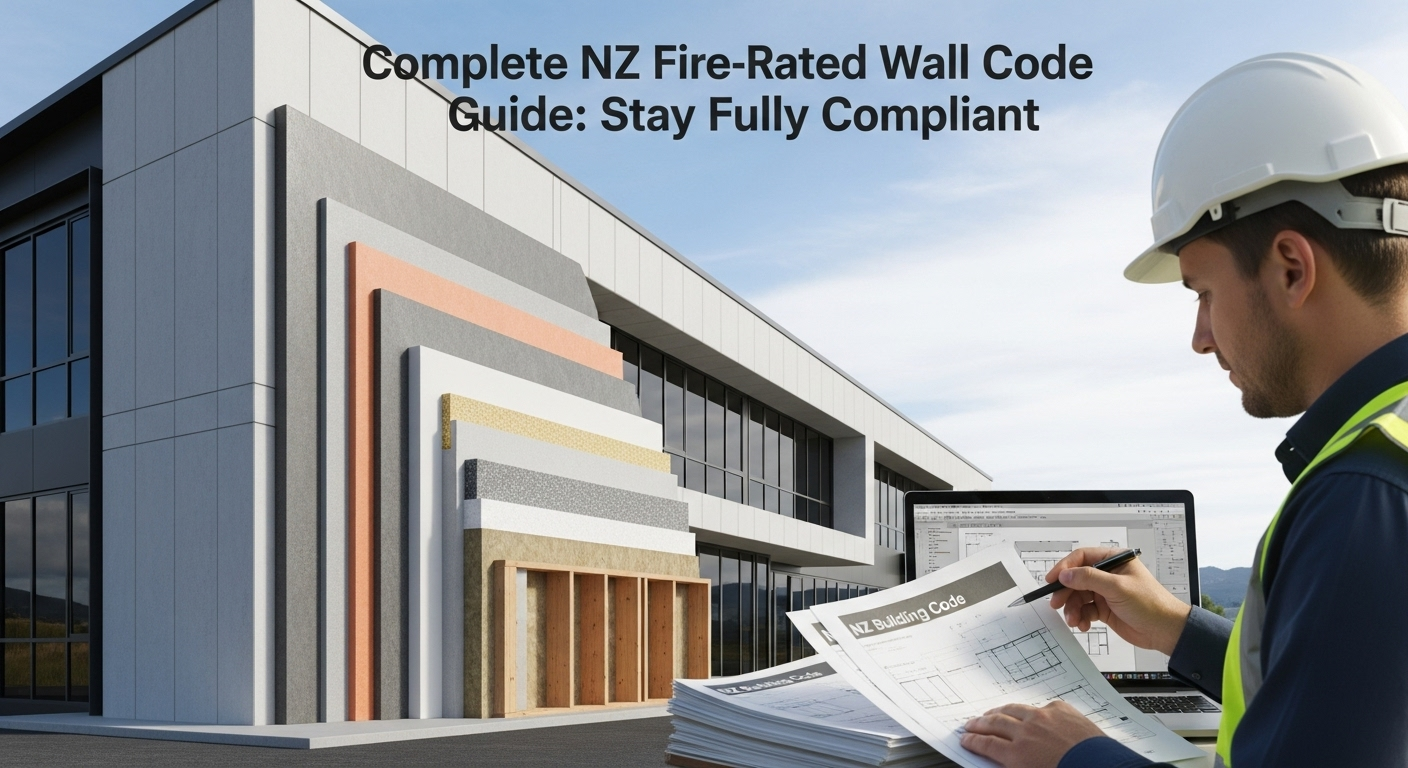Understanding the Foundation: The NZ Building Code and Fire Safety
Complete NZ Fire-Rated Wall Code Guide – The entire framework for building safety in New Zealand is established by the Building Act 2004. The Act sets out the overarching rules and purpose, but the specific performance requirements are detailed in the New Zealand Building Code (NZBC). The NZBC is a performance-based code, meaning it states what a building must achieve rather than prescribing exactly how to build it.
To help designers and builders meet these performance requirements, the Ministry of Business, Innovation and Employment (MBIE) provides Acceptable Solutions and Verification Methods. These are pre-approved ways of demonstrating compliance. For fire safety, the key documents are the Acceptable Solutions C/AS1 to C/AS7. While you can use an alternative design, following an Acceptable Solution provides a straightforward path to compliance with the nz fire rated wall building code.

Decoding the Core Concepts of Fire-Rated Walls
To effectively apply the code, you must first understand the language and core principles that define fire-rated construction. These terms and concepts are the building blocks for every decision you make regarding fire safety design.
What is a Fire Resistance Rating (FRR)?
The cornerstone of fire-rated design is the Fire Resistance Rating (FRR). This rating, expressed in minutes (e.g., 30/30/30 or 60/60/60), quantifies how long a specific building element, like a wall, can withstand a standard fire test. The FRR is composed of three critical performance criteria:
- Stability: The ability of the element to maintain its load-bearing capacity during the fire. For non-load-bearing walls, this number is often represented by a dash (‘-‘). For example, -/60/60.
- Integrity: The ability of the element to prevent the passage of flames and hot gases. A failure in integrity means fire has breached the barrier.
- Insulation: The ability of the element to limit the temperature rise on the non-fire side. This prevents the fire from spreading through heat radiation, which could ignite materials on the other side of the wall.
A wall with an FRR of 60/60/60 is expected to maintain its stability, integrity, and insulation for at least 60 minutes under test conditions. Understanding the nz fire rated wall building code means knowing which FRR is required for any given situation.
Key Clauses of the NZ Building Code for Fire Safety
The NZBC’s “C” clauses specifically address protection from fire. While all are interconnected, several are directly relevant to the design of fire-rated walls.
- Clause C1 (Outbreak of Fire): Focuses on controlling fire sources and surface finishes to limit the likelihood of a fire starting and spreading.
- Clause C2 (Means of Escape): Ensures people can escape a building safely in the event of a fire.
- Clause C3 (Spread of Fire): This is a primary clause for fire-rated walls. It aims to protect other property from fire spread and safeguard the building itself by containing the fire to its area of origin.
- Clause C4 (Structural Stability During Fire): Requires the building to maintain its structural integrity for a sufficient period to allow for safe evacuation and firefighting operations. This directly relates to the ‘Stability’ component of an FRR.
Your wall design must satisfy the performance requirements outlined in these clauses, particularly C3 and C4, to be deemed compliant.
How to Determine the Required FRR
The required FRR for a wall is not a one-size-fits-all number. It depends on several risk factors defined within the nz fire rated wall building code and its associated Acceptable Solutions. Key factors include:
- Building Use and Occupancy: The purpose of the building (e.g., residential, commercial, storage) and the number of people it holds significantly impacts the risk profile. A hospital will have far more stringent requirements than a simple storage shed.
- Firecell Size: A firecell is a space within a building enclosed by fire-rated elements. The code limits the size of firecells to control the potential scale of a fire. Walls separating firecells require a specific FRR.
- Proximity to Property Boundaries: External walls close to a boundary line must be fire-rated to prevent fire from spreading to neighbouring properties. This is known as external fire spread protection. The required FRR increases as the distance to the boundary decreases.
- Building Height: Taller buildings present greater evacuation challenges and firefighting risks, generally requiring higher FRRs for structural elements and compartmentation walls.
Designers use the tables and criteria within Acceptable Solution C/AS1 to C/AS7 to determine the specific FRR needed for each wall in a project based on these factors.
Practical Application: Building a Compliant Fire-Rated Wall
Knowing the rules is only half the battle. Successful implementation requires careful selection of materials and meticulous attention to construction detail. A fire-rated system is only as strong as its weakest link.
Common Materials and Systems for Fire-Rated Construction
Several tested and approved systems are available in New Zealand to achieve the required FRR. It is crucial to use a complete, tested system from a single manufacturer and not mix and match components.
- Plasterboard Systems: Specialised fire-rated gypsum plasterboard, such as GIB Fyreline® or GIB® Braceline GIB Noiseline®, is the most common material for creating fire-rated walls in light timber or steel framing. The FRR is achieved by using specific thicknesses, a certain number of layers, specified fasteners at precise spacings, and a particular framing setup.
- Concrete and Masonry: Poured concrete, precast concrete panels, and concrete masonry blocks inherently offer excellent fire resistance. The FRR is determined by the thickness of the material and the specific concrete cover over reinforcing steel.
- Proprietary Panels: Various specialized panels, such as aerated concrete panels (AAC) and composite mineral fibre panels, are designed and tested to provide high FRRs. These are often used for inter-tenancy walls and boundary walls.
- Intumescent Coatings: These special paints can be applied to structural steel to provide an FRR. When exposed to heat, the paint swells to form an insulating char layer, protecting the steel from weakening.
The manufacturer’s technical literature is an essential part of the nz fire rated wall building code compliance documentation, as it details exactly how the system must be installed to achieve its tested rating.
Critical Construction Details You Cannot Ignore
The majority of compliance failures for fire-rated walls occur not because the wrong primary materials were used, but because of poor attention to detail at junctions and openings.
Penetrations for Services
Walls are rarely solid barriers; they are penetrated by pipes, cables, ducts, and outlets. Every one of these openings creates a potential path for fire and smoke, completely negating the wall’s FRR if not treated correctly.
- Fire Stopping: All gaps around services passing through a fire-rated wall must be sealed with a tested fire-stopping system. This could be a fire-rated sealant (mastic), fire collars for plastic pipes (which expand to crush the melting pipe and seal the hole), or fire pillows for larger, mixed-penetration openings. The fire-stopping system must have an FRR at least equal to that of the wall itself.
- Electrical Outlets: Back-to-back electrical outlets in a fire-rated plasterboard wall create a significant weakness. They must be offset by a specified distance or protected with approved fire-rated putty pads placed inside the outlet box.
Joints and Junctions
The connections between a fire-rated wall and other building elements are just as critical as the wall itself.
- Wall-to-Floor/Ceiling Junctions: The top and bottom of the wall must be correctly sealed to the floor and ceiling. This often requires specific types of sealants and framing details, especially in systems designed to allow for building movement or deflection without compromising the fire seal.
- Control Joints: In long walls, control joints are needed to manage material movement. These joints must be designed and constructed using tested fire-rated systems, often involving specialized sealants and backing materials, to maintain the wall’s integrity and insulation performance across the joint.
Failure to correctly detail penetrations and junctions is a direct violation of the nz fire rated wall building code and will result in a failed inspection.

Navigating the Consent and Compliance Pathway
Ensuring your project complies with the nz fire rated wall building code is a formal process that involves documentation, inspection, and sign-off. Understanding this process is key to avoiding delays and ensuring a smooth project delivery.
The Building Consent Authority (BCA), typically your local council, is responsible for reviewing your plans and specifications to ensure they meet NZBC requirements before issuing a Building Consent. During construction, the BCA will conduct inspections to verify that the fire-rated systems are being installed as specified in the consent documents.
To prove compliance, designers often provide a Producer Statement (PS1 – Design), which states that their design complies with the building code. After construction, the contractor or a registered professional may provide a Producer Statement (PS3 – Construction), and the person who monitored the construction provides a PS4 – Construction Review, confirming that the work was completed in accordance with the consented plans and the nz fire rated wall building code.
Common pitfalls to avoid include:
- Substituting materials: Using a different brand of plasterboard or sealant than what was specified in the tested system.
- On-site modifications: Cutting new, unapproved openings in a completed fire-rated wall.
- Inadequate documentation: Failing to provide the BCA with the manufacturer’s technical data sheets for the specific systems being used.
Conclusion: Prioritising Safety Through Compliance
Mastering the nz fire rated wall building code is a fundamental responsibility for anyone involved in New Zealand’s construction industry. It is a complex but logical system designed with one ultimate goal: to save lives. From understanding the core principles of Fire Resistance Ratings to meticulously detailing every penetration and junction, compliance is achieved through knowledge, diligence, and a commitment to quality.
Always refer to the latest versions of the NZBC Acceptable Solutions and manufacturer’s installation guides. When in doubt, engage a specialist fire engineer to provide expert guidance. By treating fire-rated wall construction with the seriousness it deserves, you not only ensure legal compliance but also contribute to building a safer Aotearoa for everyone. Your commitment to getting it right is the first and most effective line of defence against fire.






